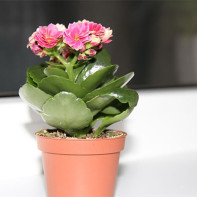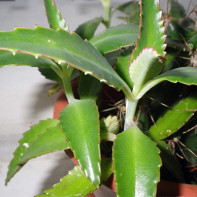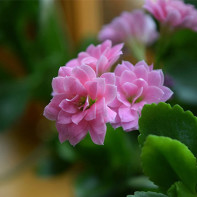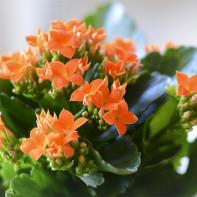Kalanchoe: medicinal properties and contraindications
Kalanchoe is often called home ginseng or room doctor.
- Chemical composition
- What does Kalanchoe look like?
- Kinds
- Collection and storage
- The healing properties of Kalanchoe
- For women
- For men
- During pregnancy
- For kids
- When losing weight
- Kalanchoe in folk medicine
- With diabetes
- With gastritis
- For the intestines
- For the liver
- With hemorrhoids
- From prostatitis
- Against cough
- From a cold
- With sinusitis
- For joints
- From varicose veins
- With a cold
- From warts
- With angina
- From burns
- Cold sore
- Toothache
- Types of healing compounds with Kalanchoe
- Infusion
- Tincture
- Decoction
- Ointment
- Butter
- Juice
- Application in cosmetology
- For beautiful skin
- Youth Skin Lotion
- For beautiful hair
- For hands and nails
- How to care for Kalanchoe
- Is it possible to eat Kalanchoe leaves fresh
- Is Kalanchoe Poisonous for Cats?
- Contraindications
Chemical composition
Kalanchoe is a plant rich in various beneficial substances. Its leaves contain complex carbohydrates, polysaccharides, which are the main sources of energy, flavonoids, very similar in composition to human hormones. They contain many organic acids (citric, malic, oxalic, acetic), which maintain the acid-base balance in the body.
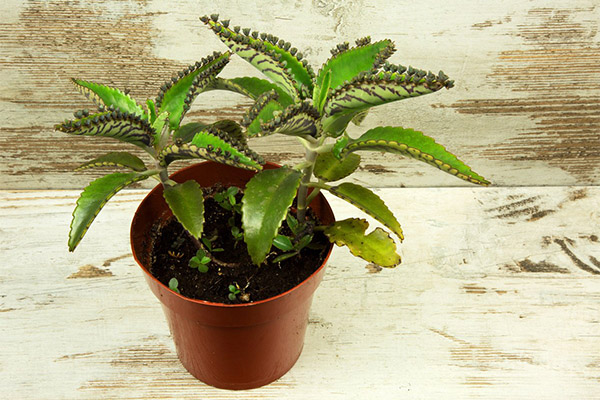
Also in the plant are vitamins C and P, tannins, cardiac glycosides and a large number of minerals, including calcium, magnesium, aluminum, iron, copper, silicon, manganese. Each of these substances is essential for the normal functioning of the body.
What does Kalanchoe look like?
Often people argue among themselves about a houseplant. One points to a flower with a sharp leaf and says that it is a Kalanchoe. The second does not agree: they say that Kalanchoe leaves with smoothly rounded edges. Most often both arguers are right: almost 200 plant species belong to this genus of botany, and they are very different from each other! Some are huge trees almost 4 m high, while others are very tiny bushes no more than 20 cm high.
And their leaves and stems differ from each other: in size, and shape, and color, which can be juicy green, and maybe almost blue.
Kinds
Among this variety of species of Kalanchoe with therapeutic purposes, only three are used - Kalanchoe Degremon, Kalanchoe pinnate and Kalanchoe Blossfeld.
- Kalanchoe Degremona - this flower was called by the grandmothers a surgeon without a knife and was necessarily bred on her windowsill, because they were well aware of its medicinal abilities. And until now, it is him who is more often than other types used for treatment at home. This plant has leathery, elongated leaves, shiny, slightly bent along in half, with a pointed tip and small teeth along the entire perimeter of the leaf. Many tiny plants grow on these cloves, which, despite their small size, have a completely finished appearance - even to their own roots. When these plants fall, they perfectly take root and begin to live their own lives. This non-flowering species of Kalanchoe is usually kept in the house precisely because of its healing qualities.
- Kalanchoe pinnate - also a satisfied frequent tenant of window sills. It is grown for decorativeness and most often does not even suggest that it is actually useful. And those who are aware of his healing abilities gave him the name home ginseng. This plant is blooming, although it rarely produces flowers in the apartment. They are small - a little less than 1 cm, have a pinkish-yellow color and are collected in inflorescences located in the axils of the leaves. The leaves themselves are large, sometimes they grow up to 20 cm in length and up to 12 cm wide. The leaves are serrated, and buds are formed in the cloves, which are used to propagate the plants. This type of Kalanchoe is grown on an industrial scale to obtain medicines for dentistry, surgery, gynecology.
- Kalanchoe Blossfeld is the third species widely distributed in homes and suitable for medicinal use. It blooms very decoratively with white, red or orange small flowers, collected in fairly noticeable inflorescences. It blooms usually in winter and pleases with bright flowers almost until May. The leaves of Kalanchoe Blossfeld are not very large - about 5 cm, but juicy, shiny and fleshy.
These three species practically coincide in their healing qualities and can be used to treat the same diseases.
Florists, who are passionate fans of Kalanchoe, grow several more species of this plant, but they no longer have practical applications and are not used for the preparation of medicinal products.
Collection and storage
Since Kalanchoe is bred at home year-round, there is no particular need to harvest kilograms of plants for future use. At any time of the year, you can go to the windowsill and pick the right sheet if this is urgently needed.
If it is decided to prepare a medicinal composition for the planned treatment, it is necessary to stop watering the plants a week before the collection of raw materials. After this period, the leaves need to be cut off (it is best to choose the ones that grow from below), wash, wipe with a towel and put in the refrigerator for another 5-7 days. Let them lie in a fruit box: in this way, the biological mechanisms of the production and accumulation of beneficial properties are launched. And only after this you can prepare decoctions, tinctures, infusions and other medicines, as well as squeeze the juice.
The healing properties of Kalanchoe
Due to the large number of vitamins, minerals and other natural substances, Kalanchoe has an extensive list of useful abilities that allow you to use the plant for medical purposes. In particular, he knows how to destroy dangerous microorganisms, that is, he has bactericidal properties. Kalanchoe can stop the growth of bacteria, in other words, has bacteriostatic properties.
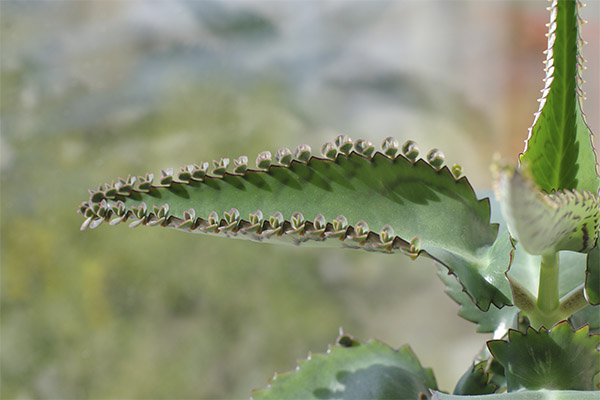
In practice, its ability to inhibit the inflammatory process, stop the blood, draw dead tissue from the wounds (that's where the name “surgeon without a knife” comes from) and heal injuries is used. Medicine uses it in various fields. For example, otorhinolaryngologists treat a plant with tonsillitis, rhinitis, sinusitis, sinusitis. Influenza, acute respiratory infections and acute respiratory viral infections - also in the field of application of the plant. In dentistry, the properties of the plant are used in the fight against stomatitis, gingivitis and periodontal disease. It also helps to solve skin problems and treats eczema, acne, psoriasis.
The plant is very widely used in the treatment of all kinds of wounds, ulcers, erosions, cracks, varicose veins.
For women
Kalanchoe is also successfully used in the treatment of gynecological diseases. He can help heal cervical erosion, relieve inflammation of the cervical canal mucosa (or cervicitis). After childbirth, the juice of a medicinal plant promotes the speedy healing of tears and deep cracks in the perineum. To do this, it is recommended for several minutes to apply a gauze napkin moistened with juice on the wound, having previously lubricated the skin around the crack with furacilin ointment or syntomycin emulsion. As a rule, 5 days is enough for such procedures.
Kalanchoe also helps to heal the cracks in the nipples, which often appear in women immediately after childbirth, just starting to breastfeed the baby. To do this, its juice needs to be dripped on the nipples 4 to 5 times a day. It is most convenient to use a pipette. Cracks will disappear after about 6-7 days.
The flavonoids contained in the medicinal plant will help to survive the unpleasant symptoms during the pre- and postmenopause easier. In their structure, they are similar to female sex hormones and have the ability to reduce the amount of lipids in the blood and weaken the rate of oxidative processes, which makes the process of aging of the body smoother and less painful.
For men
This natural medicine can be successfully used not only by women, but also by men.In particular, it helps to improve well-being with prostate adenoma and prostatitis, which is not uncommon in men who have little movement and are overweight. For these reasons, circulation in the pelvic organs is difficult, which becomes the cause of the disease. For treatment, either fresh leaves of Kalanchoe or alcohol tincture are used. The sheet can be applied to the sore spot entirely, compresses can be made from the tincture.
Also, due to the presence of flavonoids in the plant, it becomes a good prophylactic that prevents prostate cancer. The benefits of Kalanchoe are confirmed by research. Certain compounds can prevent the development of prostate cancer. The beneficial properties of flavonoids for men were confirmed by a study that proved that the risk of this disease is reduced by 30% if you regularly chew a leaf of Kalanchoe.
During pregnancy
Every pregnant woman, trying to save the future baby from the negative effects of chemical drugs, with a cold, tries to find folk remedies for treatment. In this case, Kalanchoe will be a good helper: you can treat a runny nose with its juice. In order not to get a mucous burn, it is better to dilute the juice in half with boiled water. The resulting drops should be instilled into the nose in the mornings and evenings. As a result, much less mucus is secreted, the woman gets the opportunity to breathe freely.
Those who have high blood pressure or have a predisposition to this, use such a tool very carefully. Individual intolerance to the plant is also possible.
For kids
Treating a runny nose in children with the help of Kalanchoe is a long-standing tradition, in some families this method has been used for several generations. It is important to remember that babies up to one year old do not need to use Kalanchoe. Those who are older can only dig a decoction of the plant, but not the juice. When the child has grown up, and he is already 10 years old, you can start making drops of juice, and be sure to dilute with boiled water in equal proportions. Cotton swabs soaked with these drops also help well if you put them in each nostril for 5-6 minutes in the mornings and evenings. You can not add the juice of other plants to the drops, for example, aloe or onion.
Before dripping the healing fluid in the child’s nose, you need to conduct a sensitivity test - drop one drop on the inner surface of the elbow and observe if redness appears. This rule applies to children of all ages, and all dosage forms - both juice and broth.
Doctors do not recommend formulations based on this plant if the child has a fever.
Parents need to understand that drops from Kalanchoe help only with inflamed adenoids, colds, acute respiratory infections, or SARS. They can’t get rid of a cold of an allergic or physiological nature, in such cases you need to look for other means.
When losing weight
No obvious effect for losing weight for Kalanchoe, but if you use it as a strengthening and improving digestion remedy, it is quite suitable for inclusion in a comprehensive weight loss program.
Kalanchoe in folk medicine
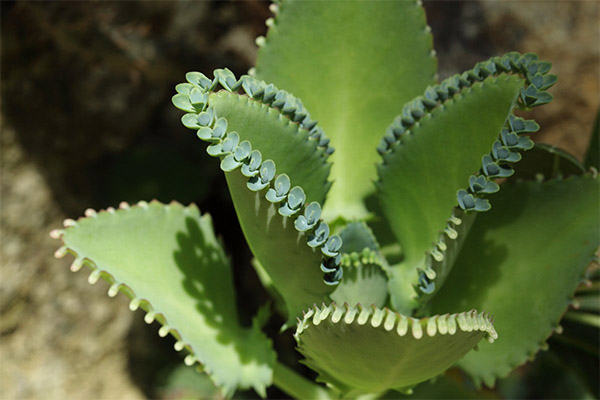
With diabetes
If a patient with diabetes mellitus consults with a doctor about the benefits of Kalanchoe for diabetes, the doctor will definitely explain that with this disease, the body needs constant calcium supplementation, which is in sufficient quantity in the juice squeezed from the leaves of the plant. If the patient normally tolerates Kalanchoe, you can safely take it a day in a tablespoon. The main thing is not to overdo it and not try to increase the dose. During the course of diabetes, this will not positively affect, but you can harm yourself.
You can add insulin to the juice and take this composition for a month. But first you need to consult a doctor.
In addition, those with diabetes often have leg problems. Even the smallest injury, scratch or blister can trigger a large infectious process and result in a trophic ulcer.Such ulcers are also treated with kalahoe juice mixed with novocaine, lanolin and furazolidone.
Lubricate sore spots up to 4 times a day. At first, after the procedure, the ulcer will quite noticeably burn and pinch, but after 7 minutes the pain will pass.
You can apply lotions to ulcers using Kalanchoe juice with the addition of aloe juice. It is necessary to mix juices equally, soak a bandage with them and apply to the wound.
With gastritis
Gastritis is treated by taking Kalanchoe juice inside. It has a beneficial effect on the gastric mucosa, reducing and then removing the inflammatory process, stimulates tissue repair and reduces pain. To alleviate the course of gastritis, you can drink a teaspoon of juice 3 times a day.
If you mix the juice in half with an infusion of juniper berries and leaves of the centaury and watch, and then drink this remedy on a tablespoon, the secretory activity of the stomach intensifies, the process of digesting food is facilitated. Therefore, it is necessary to take the healing composition before eating.
For the intestines
To treat problems with the intestines, you need to prepare an alcohol tincture: pour the cut leaflets into about a third of the volume in a completely dry jar of dark glass and add alcohol to the top of the container. In a clogged form, insist a week, after straining, store in the same container made of dark glass. Use not only for treatment, but also for the prevention of gastroduodenitis, colitis and enterocolitis: daily intake is a teaspoon 15–20 minutes before each full meal (snacks are not considered).
To alleviate the condition in acute colitis, you need to mix tincture with a decoction of yarrow herb. This tool is softer, and the taste is not so sharp. It is necessary to pour a tablespoon of grass with a small glass of water, boil over low heat for 10 minutes and, when cool, strain the broth. Dilute the tincture with a decoction in half, take 5 to 7 times a day for a tablespoon. The pains will decrease, the stool will return to normal, the appetite and the condition of the body as a whole will improve.
Exacerbations of chronic colitis can be prevented by taking this remedy: take equally leaves of Kalanchoe and plantain, turn them through a meat grinder and pour a very small amount of water - so that it only covers the mixture of leaves. After 20 minutes, squeeze out the liquid and drink the healing composition in a tablespoon 3 times a day. After a course of 15-20 days, you need to take a break for a month.
For the liver
All problems in the work of the liver and the gallbladder accompanying it, as a rule, are due to inflammatory processes, as a result of which bile formation is disturbed, various stagnant phenomena appear.
With these problems, a collection in which Kalanchoe is present will help. We need to take calendula, dill seeds, Kalanchoe babies, juniper fruits, (2 tablespoons each). Add chamomile, wild strawberry, wild rose, horsetail, corn stigmas (4 tablespoons each). Pour 3 tablespoons of the collection with a half liter of boiling water, insist one and a half hours, strain and take a whole glass 15 minutes before meals 3 times a day.
Another collection: take a spoonful of St. John's wort and as many children of Kalanchoe in a glass of boiling water. Pour and insist 2 hours. Add a tablespoon to tea. Drink a course of 5 to 7 days.
Important: before applying liver fees you need to do an ultrasound!
With hemorrhoids
The use of compounds with Kalanchoe for the treatment of hemorrhoids is based on its ability to reduce inflammation, normalize blood circulation and anesthetize. To do this, you can make compresses, lotions or baths.
Soak the plant with a gauze napkin and carefully apply it to the inflamed and enlarged hemorrhoid. Keep the healing composition in a sore spot for 15 to 20 minutes.
Well help with hemorrhoids baths. For them, half a glass of juice should be mixed with infusion from the following set of medicinal herbs: horsetail (30 g), oak bark (50 g), valerian root (20 g). To get the infusion, one tablespoon of the mixture is enough. Pour half a glass of boiling water over it. After an hour of insisting the healing composition is ready.Pour the infusion mixed with Kalanchoe juice into a basin with warm water (it should not be hot!) And sit in it for 15 minutes.
The ointment from Kalanchoe juice and Vaseline, taken in a 1: 3 ratio, has a good effect on hemorrhoidal nodes.
From prostatitis
An alcohol tincture is used to treat inflammation of the prostate. You need to take 100 g of leaves and fill them with 200 ml of alcohol. Filter the medicine after insisting for 10 days in a dark place. Take the medicine inside - before breakfast, take a teaspoon, as well as an hour before bedtime. As soon as improvement is felt, the dosage is best reduced.
You can apply another scheme for the use of tinctures - drink 1 time per day, on an empty stomach, but increase the amount of the drug to 1.5 teaspoons. In this case, continue taking until the symptoms disappear completely.
Each patient chooses a suitable treatment method - but only after consulting a doctor.
For preventive purposes, it is recommended to chew a slice of a fresh leaf of Kalanchoe every day.
Against cough
If tormented by a paroxysmal lingering cough, a mixture of Kalanchoe juice with melted butter in a 1: 1 ratio will help. Before breakfast, lunch or dinner, you should drink a tablespoon of this remedy.
Another old-fashioned, but surefire way: cut the bottom of the black radish, make a deepening in it and put very finely chopped Kalanchoe leaves and a spoonful of honey in it. Cover the recess with the cut bottom and put the radish in the refrigerator. When juice stands out, drain it and drink a tablespoon before eating. Radish can be reused, and it is better to grind Kalanchoe anew.
From a cold
An excellent cold remedy is obtained from a mixture of Kalanchoe with aloe. It is necessary to mix in equal proportions the juice of these two plants. You can immediately prepare the daily rate and put it in the refrigerator. Instill 3 drops in each nostril.
Kalanchoe has been well established for the treatment of the common cold and in a duet with onions - the juice of both plants also needs to be mixed in half. However, this rather aggressive mixture is not suitable for everyone - it may well burn the mucous membrane. Therefore, before dripping into the nose, it is necessary to apply the composition to the inner fold of the elbow. If there is no redness, you can safely use it to combat the common cold.
Another option for homemade drops from a cold - Kalanchoe juice with a decoction of St. John's wort or lemon balm. Mix liquids in equal proportions. Such a composition not only makes it possible to breathe normally, but also has an antimicrobial and anti-inflammatory effect.
These funds are suitable only for adults, in children under 10 years old they can burn the mucous membrane. Children are better to treat a runny nose with a decoction of Kalanchoe.
With sinusitis
If a cold or SARS has gone too far and the patient has been diagnosed with sinusitis, it is necessary to be treated with the help of tinctures from Kalanchoe with aloe: instill 2 drops 3 times a day. The head must be thrown back.
To make treatment faster, you can additionally once a day, preferably before bedtime, put cotton swabs with ointment on them in the nostrils for 5-6 minutes. It is also easy to prepare at home: you need to mix a tablespoon of Kalanchoe juice with 50 g of petroleum jelly and the same amount of lanolin.
If the inflammation has spread to several sinuses and sinusitis has developed, a stronger and more effective ointment is needed. To prepare it for the previous recipe, you need to add a teaspoon of aloe juice, onion and cyclamen root, mix and put Vishnevsky ointment (10 g) in the resulting mixture. Treatment with this composition should be carried out 3 times a day. The general course lasts 25-30 days.
For joints
It must be remembered: compounds with Kalanchoe for the treatment of joint problems are used only externally! In this case, they will not cause complications, will be useful, improve motor activity, remove inflammation and pain.
To prepare the composition for grinding, 4 tablespoons of crushed leaves need to be poured with a half liter of alcohol in a glass or enameled container. Under a tightly closed lid, insist the composition for about two weeks.Store the finished product in the refrigerator, and rub the diseased joints with it - once a day.
You can get rid of pain with a compress, for which mix alcohol tincture with chalk and one or two tablespoons of kefir. It is necessary to achieve that the consistency of the mixture was similar to sour cream.
At night, before you go to bed, you need to smear the affected joint with the prepared product, cover it with plastic wrap and wrap it with a bandage or a suitable cloth. Sleep with such a compress all night.
You can make another composition for grinding: mix in equal proportions honey, Kalanchoe juice and grated black radish. Before using this tool, you need to let it brew for a couple of hours.
A good effect is obtained from grinding with the help of a composition of juice and grated (or turned into a meat grinder) horseradish.
From varicose veins
An alcohol tincture of Kalanchoe, which stimulates blood circulation in the legs, has a good effect on the veins. Therefore, those who suffer from varicose veins can be rubbed into the legs in the direction from the bottom up - from the foot to the hips - tincture of Kalanchoe. It improves blood microcirculation, due to which it will be possible to significantly reduce the number of spider veins. Relieving heaviness in the legs, reducing pain, getting rid of cramps will not take long. To get a lasting effect of cure for a long time, you need to carry out procedures with tincture for at least four months.
Tincture must be prepared from 2 tablespoons of chopped leaves of Kalanchoe and half a liter of vodka. Insist the composition of 10-12 days, shaking about once a day.
With a cold
To get rid of germs and viruses, chewing Kalanchoe leaves is very good. This, by the way, will help soften the throat and relieve cough.
Cough can be treated with juice diluted in half with boiled water. Enough for a day a two-time intake of half a tablespoon. The same composition can be used as drops for the nose. With a cold, you need to drip drops - from 3 to 4 times a day. If you add a little aloe juice to the drops, then this composition will act faster and softer.
From warts
Warts and papillomas can be treated with leaves and Kalanchoe juice. It is better to use a healing plant after its two-week stay in the refrigerator. There are several ways to get rid of these skin problems.
- Firstly, you can simply rub the Kalanchoe juice in the wart in the mornings and evenings. Already on the second day it will be noticeable how the growth began to respond to treatment with a color change.
- Secondly, as a lifesaver, you can take alcohol tincture from Kalanchoe. To prepare it, mix 100 ml of vodka with 3 tablespoons of finely chopped plant leaves. After a week of infusion in a dark warm room, the remedy is ready. Rub it into the wart in the mornings and evenings until it disappears.
- Thirdly, an ointment made from Kalanchoe juice is capable of defeating warts. It must be mixed with olive oil, and take it 2 times more juice. Keep the resulting composition for half an hour with constant stirring in a water bath. When it cools, you can rub it into the growths on the skin.
In order for Kalanchoe to work more efficiently, before any of these procedures, you need to smear the wart with a decoction of wormwood, celandine or calendula.
With angina
Drops from Kalanchoe with aloe, prepared for instillation into the nose with a cold, can also be used to treat tonsillitis and tonsillitis. To rinse the drops, you need to dilute in equal proportions with boiled water - and the solution is ready. To treat not only the throat, but also the nasopharynx, you can instill this diluted solution 4–5 times a day into the nose — 2 drops in each nostril. Such a composition can also be used to treat children.
From burns
With frostbite, you can simply drip Kalanchoe juice on a damaged sore spot. The procedure is repeated from 3 to 4 times a day.
You can not squeeze the juice, but use a whole leaf of the plant, applying it to the wound and securing it with a bandage. After 4 hours, change the sheet and take a fresh one.
If the wound is large enough, and one sheet can not do, you can soak a gauze napkin with juice and attach it.This dressing must be removed after 5 hours.
Cold sore
Itching and burning during rashes of a herpetic nature can be relieved with the help of Kalanchoe juice due to its immunostimulating and antiseptic actions. You can enhance the effect of the juice by adding a little honey. Such a composition is suitable not only for lubricating the rashes, but also for oral administration.
You can not squeeze the juice, but use crushed leaves. To do this, you need to take equally the mass of leaves and honey, mix the components and let it brew for 10 hours. Eat this tasty medicine in a tablespoon 3 to 4 times a day.
Toothache
The action of Kalanchoe juice is very similar to novocaine, so it can be used to neutralize toothache. Shredded leaves should be applied to the cheek, covered with plastic wrap and tied with a warm scarf to speed up the anesthesia process.
Alcohol tincture also relieves pain and with various problems in the oral cavity - stomatitis, gingivitis and periodontitis. You can rinse with alcohol tincture alone or dilute it with calamus setting. Instead of rinsing, you can make applications: soak gauze napkins with the juice of the plant and apply to the gums.
With stomatitis, tampons moistened with Kalanchoe juice have a good effect. Repeat this procedure up to 4 times a day, hold tampons for 10-12 minutes. Relief will come pretty quickly.
Types of healing compounds with Kalanchoe

Infusion
To prepare the infusion, chopped leaves of Kalanchoe need to be poured with boiling water in an enameled pan. For external use, the proportions should be 1: 5, for internal - 1:10. Then simmer the composition in a water bath for 15 to 20 minutes under a closed lid.
Infusion can be used as lotions for the treatment of burns, festering wounds, varicose veins, skin problems. They gargle with a mouth in case of inflammation.
Inside, this composition is recommended for treatment of diseases of the digestive system, getting rid of gynecological problems. He also worked well in cases of gastritis with low acidity and chronic colitis. With colitis, the infusion is recommended to be taken half an hour before meals twice a day for a month.
Tincture
An alcohol tincture has a rather long shelf life - a year. Therefore, you can immediately prepare more of this medicine. You need to take the leaves that lie in the refrigerator, cut them and fill them with a half-liter bottle, pour alcohol or vodka there. Cork the bottle tightly and send for a week to a dark place. During this time, it must be shaken 6-7 times. Then strain the composition, pour into another glass dish and put it in the refrigerator until the necessary case. It can be used to treat varicose veins, pustular inflammation.
Decoction
Such a decoction, popularly known as the sneezer, can treat the common cold in children under three years of age. To prepare it, 4-5 leaves of the plant need to be poured with 100 ml of water and bring to a boil over low heat. Remove and leave for another hour, then strain and pour into a glass dish. Instill one drop into each nostril. Usually after instillation, the baby sneezes. This is a normal reaction to the medicine. A runny nose after this treatment disappears after two to three days.
Ointment
Kalanchoe ointment is quite popular. Sores are applied to it, wounds and fistulas are treated. If you put a napkin with grease on an abscess, a frostbitten place or anoint a rash on the skin, it will quickly cope with acute pain. Beauticians use ointment to get rid of acne, lighten dark spots. Well, this tool is also for patients with varicose veins. Even a runny nose can be treated with an ointment: in such cases, each nostril must be treated from the inside with a medicine applied to a cotton swab.During an influenza epidemic and SARS, this method will protect against the virus.
To prepare the ointment, you need to take a tablespoon of Kalanchoe juice and add to it 100 g of lanolin and 0.25 g of novocaine and furazolidone. Mix everything well so that the composition as a result has the consistency of thick cream. Ready ointment is stored at room temperature.
Butter
Freshly squeezed Kalanchoe juice in a 1: 1 ratio should be poured into olive oil. Stir the composition and insist in a dark room for three days. The oil is ready. It can be used for cosmetic purposes (for example, to prepare masks based on it, adding decoctions of other medicinal plants - chamomile, calendula, series) or in the complex treatment of stomach ulcers. Then in the oil you need to add a little honey, boiled in a water bath for half an hour.
Juice
To get enough juice and at the same time of good quality, with a large number of useful substances, you need to prepare the leaves of the plant, which is already at least two years old. When planning a juice harvest, you need to stop watering in 7 days. It is better to cut off the most fleshy and large leaves - they will make more healing juice.
Wash the leaves, dry with a towel and put in the refrigerator, after they lie down for a week and accumulate nutrients, grind. You can crush Kalanchoe with a blender, meat grinder or garlic squeezer, and then squeeze the juice with gauze. Pour the squeezed juice into a glass dish with a well-fitted stopper and put in the refrigerator. Do not store the finished product for longer than two to three weeks.
Application in cosmetology
Homemade cosmetics from Kalanchoe are very effective and quite popular. Women learned to apply its beneficial properties to be beautiful, for which they prepare masks or lotions. It should be remembered: if the cosmetic product caused irritation or any other negative reaction appeared, the procedure must be stopped.
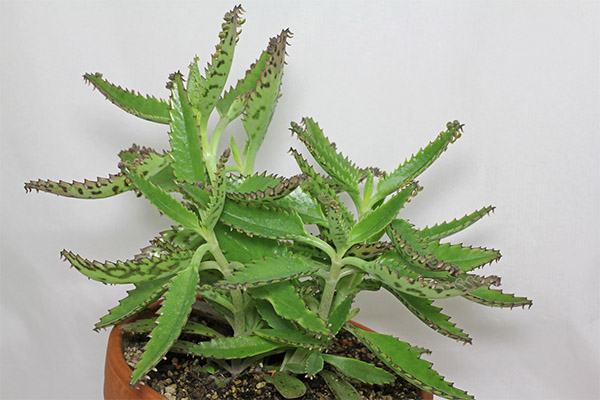
For beautiful skin
Kalanchoe is able to normalize the skin, cleanse pores, remove excess fat, relieve rashes, lighten age spots.
To cleanse the skin and acquire a beautiful color, it is necessary to remove the skin from the sheet and rub the face with flesh. Then lightly slap the skin and wait until the healing composition is absorbed. Without washing, immediately apply a moisturizer to your face.
If you need to slightly dry too oily skin, linden, chamomile and mint leaves need to be poured with a small amount of boiling water and after half an hour to drain the water. Mix Kalanchoe juice with steamed herbs and apply on face for 20–25 minutes.
Youth Skin Lotion
This tool can be used not only on oily, but also on dry skin. Mix a tablespoon of juice and half a glass of boiled water with a teaspoon of honey. You can use this tool after evening washing as a care product.
For beautiful hair
Useful products based on Kalanchoe - masks and decoctions - make hair stronger, thicker and softer, give it a beautiful shine.
For the mask you need to mix a teaspoon of Kalanchoe juice, garlic and birch, as well as honey. Add egg yolk, mix. Apply to hair, distribute the mask over their entire length, wrap cling film over the head and a large towel over it. After 2 hours, rinse off the mask with shampoo.
For hands and nails
Kalanchoe copes with softening hands. In addition, due to the antiseptic properties, it treats nail fungus with juice, as a result, both the nail plate and cuticle return to a normal, healthy state pretty soon.
You can mix a drop or two of Kalanchoe juice with a regular hand cream that is used daily. It is better to lubricate your hands before bedtime, and then wear special cotton gloves.
To get rid of the fungus, each nail needs to be wrapped with gauze soaked in juice. Then put on cotton gloves. The procedure is repeated every day, in extreme cases, every other day, until the fungus disappears.
How to care for Kalanchoe
Kalanchoe is quite unpretentious, but does not like the very hot sun, the best place for it is the east window, where the sun only happens until noon. The room should be often ventilated, but drafts are not to the liking of the plant.
The temperature must be kept in the summer + 20 ... + 25 ° С, and in the winter - + 15 ° С, otherwise the Kalanchoe may die. In summer, it would be nice to take the plant to the balcony or the veranda.
You can not water Kalanchoe very abundantly, it does not tolerate waterlogging, since the roots can begin to rot. The soil between watering should have time to dry. In summer you need to water once every 3-4 days, in winter, a break should be from 8 to 15 days. Water before irrigation should settle for a day.
The plant grows quickly, transshipment is often required, but it is better to do it in the spring. The pot should be taken 3-4 cm wider than the previous one, always pouring drainage to the bottom so that the roots do not rot. Soil is best done from a mixture of leaf and sod soil.
Kalanchoe is propagated by cuttings, seeds and children.
Is it possible to eat Kalanchoe leaves fresh
At first, people noticed the medicinal abilities of Kalanchoe and only then decided to try to use it for culinary purposes. The plant is rich in vitamins and minerals, so the dishes from it turn out to be really useful, but since its leaves have a harsh-bitter taste, they did not get wide distribution. Such dishes are more suitable for those who are interested in medical nutrition, as they help restore the body after surgery or a debilitating disease, help cleanse the blood, protect against colds, and remove harmful substances.
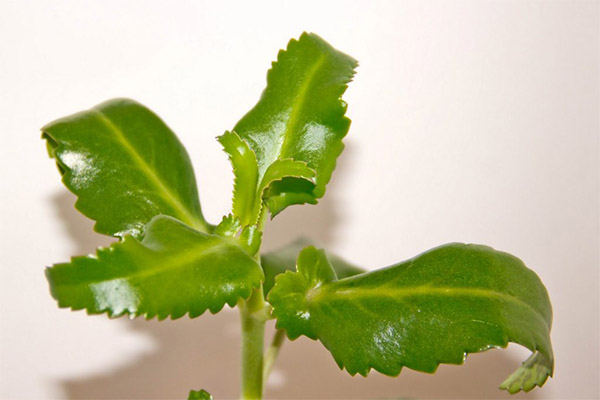
It best reduces the astringency and bitterness of Kalanchoe cucumber, so in combination with it a healing plant is quite possible in a salad.
A good combination of Kalanchoe with carrots or avocados, green salad, fresh peas in a dressing of olive oil with the addition of lemon juice.
You can try making vinaigrette with Kalanchoe. For him, as usual for such a dish, you need to boil 3 potatoes, one for beets and carrots. Peel and chop the vegetables, add 2 chopped pickles, a handful of sauerkraut to them. Cut also pickled champignons (40 g), Kalanchoe leaves (30–40 g), green onions. Salt, pour over sunflower oil - better unrefined, with the smell of seeds.
Is Kalanchoe Poisonous for Cats?
Cats quite often try to gnaw indoor plants, and not all the inhabitants of the home windowsill are useful or at least harmless to them. So, for example, although Kalanchoe is considered a medicinal plant, it is dangerous for a cat, as it can seriously damage the health of a pet and even cause poisoning. It causes irritation of the gastrointestinal tract, resulting in vomiting and diarrhea. Plant juice can in some cases even provoke heart problems, up to a violation of the heart rhythm.
Contraindications
Any medicinal plant has contraindications, and Kalanchoe is no exception. And if, as an external agent, it is practically safe, then with some diseases, health may be worsened when used internally. To avoid this, one must remember that Kalanchoe should not be used if there is an allergy to plant components and individual intolerance.
Treatment is also contraindicated in patients with asthma and diabetes mellitus to a severe degree, when the body is greatly weakened. A direct contraindication is low blood pressure, liver cirrhosis and hepatitis, joint diseases and cancer problems.
Inside, you can not use funds from Kalanchoe and pregnant women to avoid a miscarriage. External use of the plant by future mothers is quite acceptable.
«Important: all information on the site is provided exclusively in fact-finding purposes. Before applying any recommendations, consult with a profile specialist. Neither the editors nor the authors are liable for any possible harm caused materials. "


